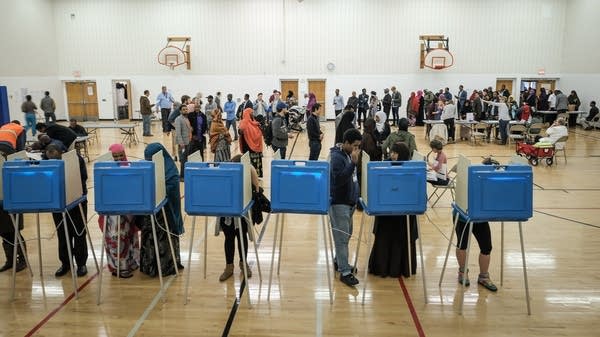Minnesota's August primaries may deliver high drama, big turnout

Go Deeper.
Create an account or log in to save stories.
Like this?
Thanks for liking this story! We have added it to a list of your favorite stories.
Minnesota summer primaries are typically sleepy affairs with lousy turnout and a call-me-in-the-fall attitude among voters.
Not this year. Instead, election observers say several high-profile party races led by the campaign for governor may drive turnout for the Aug. 14 primary to levels not seen in 20 years.
Republican-endorsed candidate Jeff Johnson faces former Republican Gov. Tim Pawlenty. On the DFL side, endorsed candidate Erin Murphy, U.S. Rep. Tim Walz and Attorney General Lori Swanson square off the gubernatorial nomination.
"There is real energy behind these primary election contests and there is uncertainty over who is going to win," said Minnesota Secretary of State Steve Simon, who oversees state elections. "I haven't seen any polling, but I don't think anyone knows what's going to happen in these races. That typically contributes to higher turnout."
Turn Up Your Support
MPR News helps you turn down the noise and build shared understanding. Turn up your support for this public resource and keep trusted journalism accessible to all.
Races beyond the gubernatorial campaigns are expected to propel the numbers as well. That includes a surprisingly contested attorney general's race triggered by Swanson's decision to run for governor as well as a five-way DFL race for U.S. Rep. Keith Ellison's 5th District congressional seat, which opened after he decided to run for attorney general.
Up north, 8th District Democrats are facing a five-way primary for an open congressional seat. Along Minnesota's southern border, Republicans have a contested primary in the open 1st District.
All the candidates are working to get their base supporters out ahead of the primary, and it's hard to predict how higher turnout might impact the races, said Eric Ostermeier, a research fellow who crunches data at the University of Minnesota Humphrey School of Public Affairs.
The 5th District primary for Ellison's seat could boost turnout of hardcore progressives in Minneapolis, he said, adding that could potentially help the more "progressive candidates" in the governor's race.
Joe Mansky, the longtime manager for Ramsey County elections, predicts turnout across the state could top 28 percent, an "extraordinary" level, he said.

State primary turnout hasn't crossed the 20 percent turnout threshold since 1998, the year that saw candidates from three of the DFLs most prominent families — Skip Humphrey, Mike Freeman and Ted Mondale.
Both major parties have faced competitive primaries in the past, but they've rarely happened in the same year.
In 1994, then-Gov. Arne Carlson lost the Republican Party's endorsement but still managed to trounce party-backed challenger Allen Quist in the primary. Democrats showed up for a four-way primary contest for governor. Total primary day turnout hit 27 percent.
In 2010, the last time there was an open governor's seat, about 16 percent of registered voters showed up for primaries, including 443,137 who voted in the Democratic race and 130,408 who voted for Republicans.
The 2014 Republican primary featured a five-way race that Johnson won with 30 percent of the vote, beating second-place finisher Kurt Zellers, who earned 24 percent of the vote. It was the most competitive GOP contest since 1924, Ostermeier said. Incumbent DFL Gov. Mark Dayton, however, wasn't facing a serious primary challenger in 2014 so overall primary turnout ran only about 10 percent.

Ostermeier said Republican activists tend to show up for the GOP-endorsed candidate, in this case Johnson. But Pawlenty was governor for two terms and has high name recognition and his own base of support.
"It's all set up for a very interesting race," he said.
Before the 2010 election, Minnesota's primary was held in September. Simon acknowledged the inherent challenge of trying to get Minnesotans to turn out on a summer Tuesday in August.
"Minnesotans do in August what you would expect them to do, which is try to squeeze the last few drops out of summer," he said, "and that has contributed to persistently low turnout."
Simon, though, noted that Minnesotans can cast their ballots early with no-excuse, absentee voting starting 46 days before the election. Absentee balloting this year starts June 29. He's pushing hard to remind people they can vote absentee early by going into a government building to vote or by requesting an absentee ballot online.
However they vote, Simon said there's been enough local and national intrigue over Minnesota politics to make Aug. 14 a potentially thrilling election day.
"This is one for the ages in terms of Minnesota political years," he said. "I've never seen anything like it."
Dear reader,
Political debates with family or friends can get heated. But what if there was a way to handle them better?
You can learn how to have civil political conversations with our new e-book!
Download our free e-book, Talking Sense: Have Hard Political Conversations, Better, and learn how to talk without the tension.




